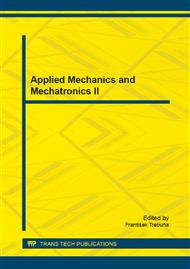[1]
L. Écsi and P. Élesztös, Moving toward a more realistic material model of a ductile material with failure mode transition. In: Materialwissenschaft und Werkstofftechnik. Vol. 43, No. 5, 2012, pp.379-387.
DOI: 10.1002/mawe.201200969
Google Scholar
[2]
J. Vavro, J. Vavro Jr, M. Krídla and A. Vavrová, Optimization of the Design of the thin shell mechanical Structures. In: University Review. Vol. 4, No. 1, 2010, pp.35-40.
Google Scholar
[3]
R. Jančo, FEM Approach of Solution of Beams on Elastic Foundation. In. Applied Mechanics, 13 th Conference Proceeding, Brno, Academy of Science of the Czech Republic, 2011, pp.71-74.
Google Scholar
[4]
Guanglong Du, Ping Zhang and Di Li, Online robot calibration based on hybrid sensors using Kalman Filters. Roboticsand Computer-Integrated Manufacturing 31, 2015, p.91–100, ISSN 0736-5845.
DOI: 10.1016/j.rcim.2014.08.002
Google Scholar
[5]
M. Hajduk, J. Semjon, M. Vagaš, Design of the welding fixture for the robotic station for spot welding based on the modular concept - 2009. In: Acta Mechanica Slovaca. Vol. 13, No. 4 2009, pp.30-36, ISSN 1335-2393.
DOI: 10.2478/v10147-010-0044-y
Google Scholar
[6]
U. Schneider, B. Olofsson, O. Sörnmo, M. Drust, A. Robertsson, M. Hägele and R. Johansson, Integrated approach to robotic machining with macro/micro-actuation. Roboticsand Computer-Integrated Manufacturing 30, 2014, p.636–647, ISSN 0736-5845.
DOI: 10.1016/j.rcim.2014.04.001
Google Scholar
[7]
G. Hirzinger, N. Sporer, M. Schedl, J. Butterfaß and M. Grebenstein, Torque-Controlled Lightweight Arms and Articulated Hands: Do We Reach Technological Limits Now? The International Journal of Robotics Research Vol. 23, No. 4–5, April–May 2004, pp.331-340.
DOI: 10.1177/0278364904042201
Google Scholar
[8]
F. Trebuňa and F. Šimčák, Handbook of Experimental Mechanics, first ed., Typopress, Košice, ISBN 970-80-8073-816-7, (2007).
Google Scholar
[9]
Information on https: /www. google. com - images light weight robots.
Google Scholar
[10]
A. Albu-Schäffer, S. Haddadin, Ch. Ott, A. Stemmer, T. Wimböck and G. Hirzinger, The DLR Lightweight Robot – Design and Control Concepts for Robots in Human Environments. Industrial Robot: An International Journal, Vol. 34 Iss. 5, pp.376-385.
DOI: 10.1108/01439910710774386
Google Scholar
[11]
M. Pástor and M. Hagara, A comparison of modern and classical experimental methods of mechanics in strain investigation. In: Applied Mechanics and Materials. Vol. 611, 2014, pp.501-505, ISSN 1660-9336.
DOI: 10.4028/www.scientific.net/amm.611.501
Google Scholar
[12]
F. Trebuňa, F. Šimčák, J. Bocko and P. Trebuňa, Failure analysis of mechanical elements in steelworks equipment by methods of experimental mechanics, Engineering Failure Analysis, 17 (4), 2010, pp.787-801.
DOI: 10.1016/j.engfailanal.2009.10.011
Google Scholar


